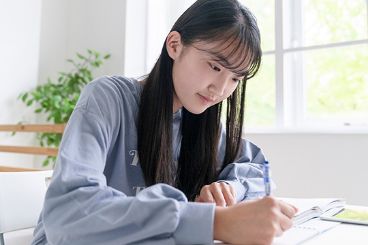HackTrek 2021 Champion Team: Creating a service to close the "rift in after-school studies during the COVID-19 pandemic"
The nationwide online hackathon "HackTrek 2021" was held at the end of February 2021. An online interview was held with three members of the "SUGOKUNARITAI Student Group," which won the hackathon. At the time of the hackathon, all the members were high school students. The interview explores various angles, from the background of how their winning idea was born to their thoughts on the current product development.
■ What is "HackTrek?"
HackTrek is a hackathon event organized by Seiko Epson Corporation (referred to below as Epson). Participants compete to bring their ideas into shape by combining the Epson Connect API with various APIs and services. HackTrek 2021 is the second HackTrek to be held following the first one in 2019 and was the first HackTrek to be held entirely online, with 53 participants from 14 teams joining in from all over Japan. A wide variety of products and services were designed in response to the theme "Accelerate smart cities."
■ Why is Epson hosting hackathons?
Epson is hosting HackTrek with these three main goals: To strengthen their relationship with developers and engage in co-creation, to utilize Epson's resources and encourage the free creation of innovative ideas, and to promote the usability and appeal of the Epson Connect API so many people can apply it to various situations. The hackathon champion and runner-up teams have already started to develop products for actual services in collaboration with Epson.
Online interview attendees
■ Mr. Yuto Takamune
Engineer, SUGOKUNARITAI Student Group
■ Mr. Kota Yatagai
Engineer, SUGOKUNARITAI Student Group
■ Mr. Daiki Tomioka
Planner & Designer, SUGOKUNARITAI Student Group
■ Kohei Shiratori
P Strategic Planning Department, Seiko Epson Corporation
*In the text, honorifics are omitted.
Curiosity about "smart cities" and the use of "Epson Connect API" sparked the motivation to join the hackathon
──Thank you for joining us today! First, I'd like to ask why you wanted to participate in the hackathon.
Takamune: To begin with, I had a strong interest in smart cities. When I was researching smart cities in Aizuwakamatsu city, Fukushima after being accepted into university, I learned of HackTrek and was curious. I belong to the online Slack community "SUGOKUNARITAI Student Group," so I went there and asked if anyone wanted to participate with me. We used the name of the community as the team name since that's how we came together.
Yatagai: When I heard about HackTrek from Yuto (Mr. Takamune), I was intrigued by the question of what products and services could be created using the Epson Connect API because I didn't have much experience using Epson printers and scanners. Another reason I decided to participate was that I wanted to experience team development through the hackathon, since my only previous experience with programming was self-taught individual development.
Tomioka: I was originally involved in robot development, which is a different field from service development. In addition, I had experience participating in business contests and thought I could apply the various designs, idea generation, and presentation methods I learned in those contests to the hackathon.
Real life challenges in the COVID-19 pandemic—facing the rift in after-school learning activities
──Please tell us about "Catenary," the service idea that won this year's hackathon. What are the key elements of this idea?

Tomioka: "Catenary" was developed based on the concept of a "bridge for after-school learning," where students can go online and ask questions to teachers after school. There are various functions for printing learning materials, making video calls, and chats. Students can choose a teacher from a list and post questions, and the teachers can see the list of requests from students. The note space allows participants to type posts directly online.
Takamune: The idea was inspired by my own experience. When I was in high school, I was the kind of student who would go to the teacher after school to ask questions about my studies. In my senior year, all classes shifted to online because of the COVID-19pandemic , and I could no longer go see the teachers after school. I felt that my last year of high school could have been more fulfilling if there had been a way to ask questions to teachers, even with online classes. When solidifying the idea, we had a tough time especially for creating a concept in line with the theme of "accelerating smart cities." In addition, there was the prerequisite rule of using the Epson Connect API. We had many discussions about creating a unique service that incorporated all of this. Above all, I believe that this service was born because we had spent over half of our high school lives in the COVID-19 pandemic, and the need for "bridging" us to teachers was an issue that we experienced firsthand.
──How did you divide your roles during the actual hackathon?
Yatagai: I was in charge of the front-end development. I spent the first day working on the UI style according to the design created by Daiki (Mr. Tomioka) and the second day writing the client code that runs behind the UI. Throughout the whole process, the neatness of the code took a back seat, as I was occupied with trying to finish writing a code that worked before our time was up.
Takamune: I was mainly responsible for managing the project's overall progress while also building on AWS and helping with programming areas that were behind schedule. The most challenging part was when I realized late at night on the first day that the back-end program I had written in Rust didn't work correctly, so I had to rewrite the whole thing in Python. In addition to that, we ran into errors with login authentication part and video calling. The development was quite hectic, but I'm glad we managed to get it working just in time for the presentation. Daiki was very particular about the UI design, and I think it turned out really cool, thanks to his efforts.
Tomioka: As the planner and designer, I was mainly in charge of the UI design and preparation of presentation materials. In terms of design, I focused especially on adopting the Neumorphism design method, which had been popular recently. The usability of the design is a large factor, but I also think enjoying creating the product is equally important, so I wanted our efforts to include the latest trend.
Continuing to "co-create" after the hackathon
──Please tell us your impressions of the hackathon and your honest feelings about the product development you are currently involved in with Epson.
Takamune: We had a lot of fun during the hackathon, and most of all, the fact that this "hackathon is not finished even when it's over" felt very original. Other hackathons I experienced in the past basically ended when the results were presented. I think the unique and appealing thing about "HackTrek" is that after the hackathon is over, Epson provides support to finalize the product so it will become available as a service. In the current development process, I'm continuing to act as the project manager and am basing our direction on product policies discussed with Daiki. I'm learning something new every day, as some parts are different from during the hackathon, such as the need to consider continuous maintainability and using scrum development for long-term schedule management.
Yatagai: This was my first time participating in team development, and I realized how much fun it is. Working on development in a well-maintained environment is also very appealing. For our collaboration with Epson, I'm working on front-end development just like in the hackathon, and there are many new things I'm learning.
Tomioka: It was honestly great to see everyone on the team demonstrating their individual strengths in their roles. In the current development phase, I'm mainly in charge of gathering information and conducting interviews. It's interesting that the actual surveys have yielded results that are different from our initial hypotheses. We weren't able to verify our hypotheses during the hackathon, so I'd like to focus on using the results to finalize our service.
──In closing, can you tell us about your future goals?
Yatagai: I'd like to continue to be involved in "Catenary" as one of the developers. Personally, I'd like to learn more about blockchain and cryptography while studying web development, and I'll do my best to become an expert in this field.
Tomioka: I was already interested in entrepreneurship in addition to programming and design, and being involved in developing "Catenary" has strengthened my resolve to move in that direction. My goal is to become a well-rounded engineer who can think about promotion and communication in addition to developing microcomputers and applications.
Takamune: I'd be happy if "Catenary" could improve school life for junior high and high school students out there. To achieve this, we need to create a service that many people can use. Hindering the creation process due to a lack of technical skills would be very frustrating, so I'd like to acquire the necessary knowledge and skills to prevent this from happening.
Promoting co-creation with young people who will be responsible for the future
──From the perspective of the HackTrek 2021 judges, what were the main points that led to the high rating of the SUGOKUNARITAI Student Group's idea for "Catenary"?
Shiratori: The idea was rated highly because the topic was something that was experienced firsthand by the members and the product was based on their proactive attitude to try solving that real-life issue by themselves. In addition, one of the features of "Catenary," which allows teachers and students to talk while sharing scanned materials online, was an idea we had not seen before in the competition. In the presentation, the team members said that it was difficult to speak candidly or make off-topic small talk when interacting only through text. This kind of genuine opinion from the students' point of view made the necessity of this product even more convincing.
──What are Epson's impressions and thoughts about the product development currently underway with the "SUGOKUNARITAI Student Group"?
Shiratori: The team members are not from a company but a community of individuals, so we appreciate that they have continued participating in the joint development. There are many issues related to education in our society. The opportunity for Epson to think about and work on these issues together with students who have actually faced them is very meaningful. Currently, the project is moving forward, and we're having regular meetings with the team members to share the progress and direction. We're also conducting interviews with users, including teachers and students, and are collecting valuable feedback, so we hope to refine the service and reach the demonstration experiment stage. We at Epson will be more than happy if "Catenary" is released as a service and gains a large user base as a new communication tool in the field of education.
──What are Epson's expectations for students and young people who will be responsible for the future?
Shiratori: The exciting aspect of IT and software fields is that the ideas of young people, and unique ideas that have not existed before, can take shape and become real without being limited by age or experience. Epson is currently promoting product development with partners under the keywords of "open innovation" and "co-creation," and many of those partners are individuals, including start-ups and students. One of the reasons we hold HackTrek is to strengthen our relationship with developers, and we want to spread awareness about our company's stance and efforts to students and others. Epson is a company that is well known for its hardware, but we also have many resources to offer in terms of services and solutions. We will continue to work together with developers across the country to solve social issues.
Interview: June 2021
Written interview content and names of organization, affiliations, and titles, etc. are as of the time of the interview.



